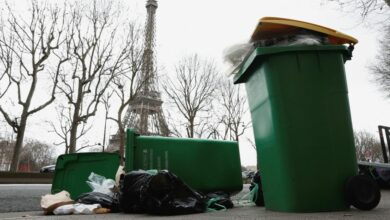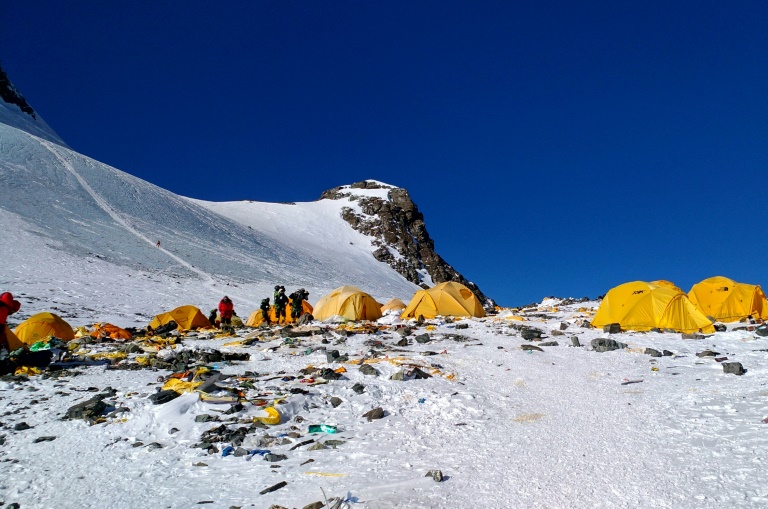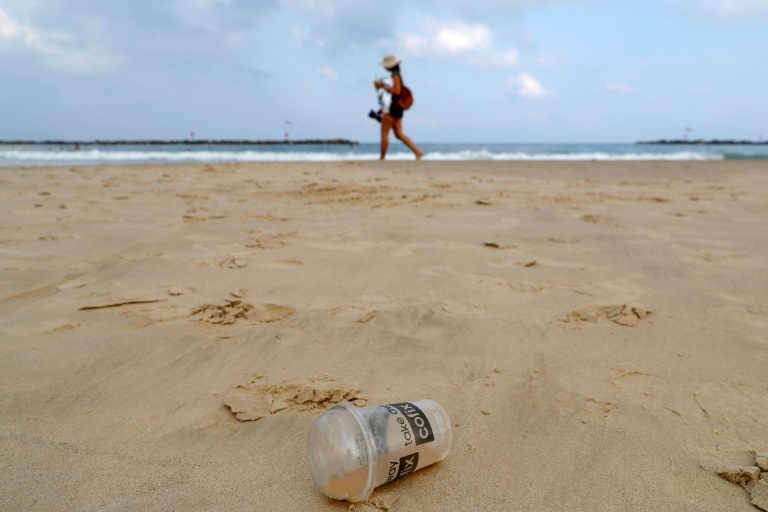
Standing on the peak of one of Gezirat al-Warraq’s trash mountains, one can see beautiful Nile vignettes, the shores of Imbaba and Shubra, and small uninhabited islands that pop in and out of existence with the changing currents.
But, looking in, the island’s problems don’t end with the piles of trash occupying the Nile banks. Poor urban planning and lack of infrastructure have led to a dire health and environment predicament here.
Poor sanitation sewage networks and waste collection, contaminated drinking water, chemical fertilizer runoff and isolation from the mainland are only a few sources of Gezirat al-Warraq’s residents’ deep-seated suffering.
“If only we had sewers, it would fix all of our problems,” one resident laments.
Visible pipes travel over trash-covered land to pump raw sewage into the Nile. Two-thirds of the country’s population is not connected to sanitary sewers, leaving biological waste improperly disposed of — often, directly into the river.
Untreated organic matter causes contamination and infections, and fecal bacteria are also an important indicator of water quality, says Sherif Baha el Din, environmental consultant and board chairman of the organization, Nature Conservation Egypt.
The growth of fecal bacteria increases the risk of water-borne pathogens and disease. On an island like Gezirat al-Warraq, which has a population of 80,000 and no structural solution to its waste problem, the health problems and environmental damage are mounting.
The island’s residents use contaminated Nile water to wash their dishes and swim, while they must depend on other sources for their drinking water. While official numbers boast a 99 percent rate of access to water in Egypt, this does not include access to potable water. Rural water sanitation coverage stands at a devastating four percent.
Water treatment facilities exist, but the water purification techniques are outdated. Ayman Ramadan, water resources adviser at the Water Resources and Irrigation Ministry and the National Water Resource Project, explains that most facilities use aluminum chloride and chlorine to treat water for human consumption, except two water plants in Cairo that use ozone and serve higher-income areas.
Aluminum chloride is a known chemical hazard that may cause Alzheimer’s disease, and chlorine is a potentially carcinogenic agent. Treatment with these chemicals has been largely replaced in the rest of the world.
The problem for Gezirat al-Warraq, however, is not in the substandard treatment techniques, but the evidence that the government water taps distribute water that does not meet the minimum requirements for human consumption.
The state of disease and healthcare on the island is intricately related to the deficiency of sanitary infrastructure and lack of proper water treatment facilities. Hepatitis C and E are rampant, the latter often propagated by fecal contaminants in the water source.
Liver disease, kidney failure, kidney stones and urinary tract infections are common illnesses on the island — even for children as young as three.
“These are normal,” says one mother, whose toddler suffers from kidney stones due to the amount of dissolved solids in the municipal tap water available for residents.
Schistosomiasis, or bilharzia — a chronic parasitic disease common in contaminated water — is endemic on the island. There is a hospital, staffed by one doctor, with a reported annual budget of LE160 to serve 80,000 people.
Residents must take an unreliable ferry to the mainland when they need medical attention. “They can die waiting for the boat,” a young boy, born on the island, interjects.
A middle-aged woman who lives next door to one of the government taps looks at the water flowing out. “They dump in it and we drink from it,” she says.
The residents are not ignorant of the state of their drinking water. Every few minutes, buckets of dirty household water, garbage and organic waste are dumped in the Nile, right outside their windows.
“We can’t trust the water on the island,” Rafat Abdel Naby Mohamed, a resident and Justice Ministry employee, states.
His wife, Amina, says she — and every woman in Gezirat al-Warraq — has to take a ferry to Shubra al-Kheima at least twice a week to buy large jerry cans of drinking water.
The symptoms of contaminated water are obvious, especially when looking at the state of the Nile surrounding the island.
Fields of reeds, white lotus plants — an invasive aquatic plant — and algae cover Gezirat al-Warraq’s Nile for meters past the garbage shores.
Agricultural land is adjacent to the river, and irrigation canals water the land while transporting runoff into the Nile. The runoff is ripe with ammonia and nitrate chemical fertilizer.
“Ammonia and nitrate increase plant production, and so it does the same in the Nile river,” Ramadan explains, saying this process is known as eutrophication. “When this growth increases, the plants consume the dissolved oxygen in the water. When they consume almost all of it, they die. When the reeds die and decompose, they use up the leftover oxygen.”
The eventual depletion of oxygen can have severe effects on animal life. “There is a direct relationship between water quality and the number of species and fish in the Nile,” says Baha el Din. This ominous environmental hazard threatens to deeply damage the biodiversity that Nile islands are blessed with.
He fears that the environmental health of the island is in danger, if not on its way to catastrophe.
A 1996 decree declared all Nile islands natural protectorates — “in theory,” Baha el Din adds, saying protected islands are “kind of a joke.”
According to Law 102/1083, a natural protectorate is an area that is deemed to be of particular natural importance and is managed in a special way to reduce damage and preserve the land value.
The Egyptian Environmental Affairs Agency is responsible for the regulation of natural protectorates. Baha el Din adds that the Nile islands are “quite valuable because they bring wildlife into the Cairo mainland. Almost all the islands have good biodiversity, but urbanizing them brings pollution directly inside the Nile … there is something to say about providing primary sewage treatment and garbage facilities so they are not large sources of pollution to the Nile. At the same time, you do not want to encourage an influx of people settling there,” he explains.
It is a catch-22, in which ignoring residents’ health needs causes further pollution and damage to the environment, but providing infrastructure will encourage increased settlement on agricultural land.
However, on-the-ground evidence indicates that little is being done to manage the land. Residents have grown tired of petitioning ministries and politicians, claiming they want to keep residents backward because they want them to leave the island.
When Egypt Independent contacted Ekhlass Gamal Eddin, head of the Egyptian Environmental Affairs Agency’s water quality department, she explicitly refused to discuss contaminated discharge into the Nile, nationwide water contamination statistics or anything specific to Gezirat al-Warraq.
“We are concerned with the whole River Nile. Gezirat al-Warraq is one area along the River Nile,” she elaborated.
The island’s political situation is complex. In 2001, the Cabinet passed Decree 542/2001, which designated the island as land for “public utilization,” despite residents’ claims that they had land deeds. The bureaucratic dance is complicated; the government allegedly wants the residents to be relocated so that the island can be appropriated for commercial and touristic uses, given its ideal location.
As Mohamed, the Justice Ministry employee, says, “We’re twice as big as Zamalek. Can you imagine how much money they can make?”
After exhausting direct government avenues, residents are turning to the media for help.
Mohamed, plumber Alaa Eddin and fabric weaver Ahmed Mohamed state residents’ demands: removing the natural protectorate status, which they say is commonly used as an excuse to block building schools, bread ovens and warehouses; an entrance/exit ramp from the Ring Road; and sanitary sewers.
“Then we will be able to live properly,” Alaa Eddin says emphatically.
Ramadan says solutions are possible and have been successfully implemented in other areas plagued by similar problems.
“We need grassroots work groups,” he says, that will “implement solutions devised by cooperation between residents, the water company, scientists and university researchers.”
While cheap ways to increase water quality and dispose of waste are possible, they take commitment, political will and a unanimous goal.
But while the quality of life on the island is substandard, and residents often admit it is near uninhabitable, some scoff at the suggestion of leaving.
“We are like fish,” Mohamed says, smiling. “Take us out of here and we will die.”
This piece was originally published in Egypt Independent's weekly print edition.





